Related Research Articles

The history of Buddhism, can be traced back to the 5th (500) century BCE. Buddhism arose in Ancient India, in and around the ancient Kingdom of Magadha, and is based on the teachings of the renunciate Siddhārtha Gautama. The religion evolved as it spread from the northeastern region of the Indian subcontinent throughout Central, East, and Southeast Asia. At one time or another, it influenced most of Asia.

Buddhism is among the smallest minority-religions in Canada, with a very slowly growing population in the country, partly the result of conversion, with only 4.6% of new immigrants identifying themselves as Buddhist. As of 2021, the census recorded 356,975 or 0.8% of the population.
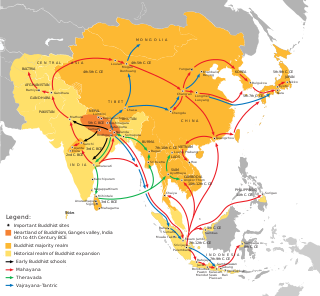
Buddhism entered Han China via the Silk Road, beginning in the 1st or 2nd century CE. The first documented translation efforts by Buddhist monks in China were in the 2nd century CE via the Kushan Empire into the Chinese territory bordering the Tarim Basin under Kanishka. These contacts transmitted strands of Sarvastivadan and Tamrashatiya Buddhism throughout the Eastern world.
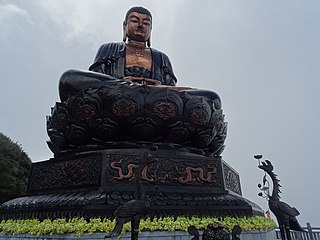
Buddhism in Vietnam, as practiced by the Vietnamese people, is a form of East Asian Mahayana Buddhism. It is the main religion in Vietnam. Vietnamese Buddhism is generally inclusive and syncretic, drawing on the main Chinese Buddhist traditions, such as Tiantai and Huayan, Zen (Thiền), and Pure Land.

Buddhism is a minority religion in Argentina, where, in addition to the majority of the Christian population, the rate of self-professed Buddhists is about 0.5%.

Buddhism is the third largest religion in France, after Christianity and Islam.

Although there was regular contact between practising Buddhists and Europeans in antiquity the former had little direct impact. In the latter half of the 19th century, Buddhism came to the attention of Western intellectuals and during the course of the following century the number of adherents has grown. There are now between 1 and 4 million Buddhists in Europe, the majority in Italy, Germany, Hungary, France and the United Kingdom.
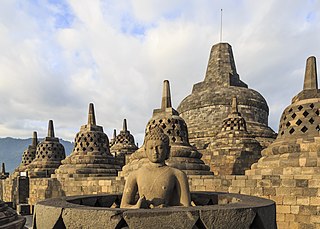
Buddhism in Southeast Asia includes a variety of traditions of Buddhism including two main traditions: Mahāyāna Buddhism and Theravāda Buddhism. Historically, Mahāyāna Buddhism had a prominent position in this region, but in modern times most countries follow the Theravāda tradition. Southeast Asian countries with a Theravāda Buddhist majority are Thailand, Cambodia, Laos and Myanmar, all mainland countries.
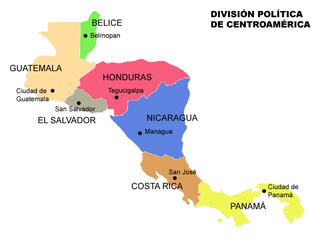
Central America is a subregion of the Americas formed by six Latin American countries and one (officially) Anglo-American country, Belize. As an isthmus it connects South America with the remainder of mainland North America, and comprises the following countries : Belize, Guatemala, Honduras, El Salvador, Nicaragua, Costa Rica, and Panama.
Chinese Nicaraguans are Nicaraguans of Chinese ancestry who immigrated to or born in Nicaragua. They are part of the Chinese diaspora.
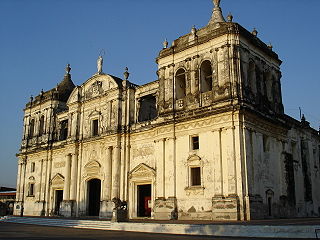
Religion in Nicaragua is predominantly Christian and forms a significant part of the culture of the country as well as its constitution. Religious freedom and religious tolerance is promoted by the Nicaraguan constitution yet the government has in recent years detained, imprisoned, and likely tortured numerous Catholic leaders, according to multiple news outlets. As of 2020, 79% of believers stated they are Christian.

Costa Rica has more Buddhists than the other countries in Central America with almost 100,000, followed closely by Panama, with almost 70,000.
Buddhism in Venezuela is practiced by very approximately 52,000 people as of 2015. The Buddhist community is made up mainly of Chinese, Japanese, and Koreans.

Religion in South Korea is diverse. Most South Koreans have no religion. Christianity and Buddhism are the dominant confessions among those who affiliate with a formal religion. Buddhism, which arrived in Korea in 372 AD, has thousands of temples built across the country.
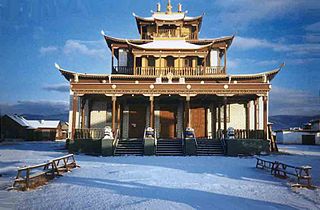
Historically, Buddhism was incorporated into Siberia in the early 17th century. Buddhism is considered to be one of Russia's traditional religions and is legally a part of Russian historical heritage. Besides the historical monastic traditions of Buryatia, Tuva and Kalmykia, the religion of Buddhism is now spreading all over Russia, with many ethnic Russian converts.

Costa Ricans are the citizens of Costa Rica, a multiethnic, Spanish-speaking nation in Central America. Costa Ricans are predominantly Castizos, other ethnic groups people of Indigenous, European, African and Asian descent.
Federación de Comunidades Budistas de España is a Spanish organisation that functions as an umbrella organisation to the country's Buddhist communities.
Luis O.Gómez was a buddhologist, translator and psychologist. He spent over three decades at the University of Michigan, working in the Department of Asian Languages and Cultures, Religious Studies Program, and the Department of Psychology. In 2007, he moved to Mexico City, where he joined the Center for Asian and African Studies at El Colegio de México as a researcher. He was born in Guayanilla, Puerto Rico.

Buddhism is the fourth-largest religion in Spain. The presence of Buddhism in Spain began in the late 1970s, brought from other parts of Europe, especially France. Despite its short history in the country, Buddhism was recognized as a deep-rooted religious confession in 2007, under official consideration. This recognition implies its equivalence in recognition with most other established religions for legal, political, and administrative purposes. Much of the Buddhist tradition in Spain has grown out of the Buddhist Union of Spain, the Federation of Buddhist Organizations of Spain, which was established in 1990. The first schools in Spain were Zen and Kagyu, and they have the largest community in the country today. There are dozens of Buddhist practising centers in the country. According to an estimation from 2018, there are around 90,000 followers of Buddhism in Spain, with a total number of around 300,000 adherents if sympathizers are included.

Buddhism in Puerto Rico is represented by two of the three major Buddhist branches: Mahayana and Vajrayana. Buddhism first arrived in Puerto Rico in the 19th century when Chinese immigrants arrived in the island either as railroad and infrastructure workers, or as a result of the Chinese Exclusion Act of 1882, which caused many Chinese Americans to flee to the then Spanish territory. Puerto Rican Buddhists come from diverse national origins, ethnicities and racial backgrounds, following trends similar to those in the United States, Europe and Latin America. Although there is a high diversity of traditions today, the number of Buddhists in Puerto Rico is not as large as in other jurisdictions and its number of practitioners fluctuates between 7,348 and 10,000, representing 0.2-0.3% of the population of Puerto Rico.
References
- ↑ "Religious freedom nation page". Archived from the original on 2006-08-29. Retrieved 2007-04-06.